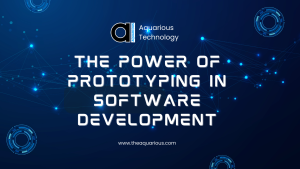The Power of Prototyping in Software Development

Introduction to Prototyping
Prototyping in software development services is a foundational process that involves creating preliminary models to showcase a product’s functionality. It serves as an initial draft, giving stakeholders a tangible representation of the final software. This approach allows for early feedback, leading to improvements and adjustments before the final product’s completion. Prototyping accelerates the development timeline, encouraging iterative modifications. Its significance lies in enabling engagement with end-users, fostering communication between stakeholders, and reducing development risks. Ultimately, it paves the way for a more user-centric, cost-effective, and efficient software development process.
Benefits of Prototyping
Speeding up the Development Process
Speeding up the development process in software development services involves expediting the phases from conception to deployment. Through rapid prototyping and agile methodologies, teams swiftly ideate, develop, and test, aiming to shorten the product’s time-to-market. It entails minimizing redundant tasks, streamlining workflows, and using pre-built components to enhance efficiency. Furthermore, leveraging automation, parallel tasks, and collaborative tools quickens the coding and testing phases. Effective time management and continuous feedback loops ensure timely adjustments, reducing developmental bottlenecks. Speeding up development not only accelerates product delivery but also allows for earlier user feedback, ultimately enhancing the overall quality of the software.
Enhancing User Engagement and Feedback
Enhancing user engagement and feedback in software development is crucial for refining products. Engaging users early in the process through prototypes fosters a collaborative environment, allowing users to interact and provide insights. Their feedback aids in identifying preferences and potential issues, shaping the final product to meet user expectations. This iterative process not only ensures user satisfaction but also enhances the usability and functionality of the software. By involving users in the development cycle, software creators gain valuable perspectives, enabling them to tailor the product according to real user needs, leading to a more successful and user-centric end result.
Reducing Costs and Mitigating Risks
Reducing costs and mitigating risks through prototyping in software development services is paramount. Early identification and rectification of potential issues during the prototype phase significantly diminish the chances of costly errors in the final product. By allowing for adjustments and refinements before the full-scale development, prototyping curtails expenses associated with post-launch modifications. Moreover, this process minimizes the risk of significant setbacks, ensuring that the final software product aligns closely with user expectations. This proactive approach not only saves resources but also increases the overall efficiency of the development cycle, leading to a more streamlined and cost-effective software creation process.
Types of Prototyping
In software development, various prototyping approaches exist, including throwaway, evolutionary, and incremental prototyping. Each method offers unique advantages and is chosen based on project requirements.
The Prototyping Process
The process involves distinct phases, starting with planning and design, moving on to development and testing, and culminating in a feedback and iteration phase. This cyclic process ensures continuous improvement.
Best Practices in Prototyping
Involving Stakeholders and End-Users
Involving stakeholders and end-users in the software development process is pivotal. It ensures alignment between the product and user needs. Engaging stakeholders – those with vested interests in the project’s success – brings diverse perspectives, enhancing the software’s functionality and user experience. End-users’ involvement allows for direct feedback, enabling developers to address concerns early in the process. This collaboration streamlines communication, guaranteeing that the final product resonates with the intended audience. It’s a vital step in creating user-centric software, fostering a sense of ownership among stakeholders and end-users while ensuring the end product meets expectations.
Using Prototyping Tools and Technologies
Using prototyping tools and technologies revolutionizes the software development landscape. These tools, ranging from simple wireframing platforms to complex interactive interfaces, empower developers to create functional prototypes. By simulating the user experience, these tools enable a more accurate representation of the final product. Advanced technologies like Axure RP, InVision, and Adobe XD streamline the prototyping process, allowing for rapid iterations and enhanced collaboration among teams. Such tools facilitate the visual depiction of the software, ensuring a better understanding of its functionality. With these, developers can efficiently test and refine design ideas, fostering a more user-centric and efficient development process.
Documenting and Implementing Feedback
Documenting and Implementing Feedback in software development is a pivotal process. It involves systematically recording all feedback gathered from stakeholders and end-users during the prototype phase. Documenting feedback ensures that valuable insights and suggestions are not lost and serves as a reference for iterative improvements. Once documented, the next crucial step is the implementation phase. It involves carefully analyzing the feedback and integrating necessary changes into the software prototype. This process greatly influences the final product, ensuring it aligns with the desired objectives and functionalities. Efficiently documenting and implementing feedback leads to a more refined, user-centric, and successful software product.
Challenges in Prototyping
Balancing Time and Resources
Managing the time and resources allocated to prototyping without hindering the project timeline is a significant challenge, requiring careful planning and resource allocation.
Managing Scope Creep
Prototyping can lead to additional feature requests that may exceed the project scope. Managing these requests without compromising the project’s core objectives is critical.
Addressing Compatibility Issues
Ensuring compatibility with various platforms, devices, and environments poses a challenge, requiring thorough testing and adaptation.
Future Trends in Prototyping
Future trends in prototyping within software development services indicate a shift towards innovative technologies and methodologies. The integration of Artificial Intelligence (AI) and Machine Learning (ML) is set to transform prototyping by automating the creation of more sophisticated and intelligent prototypes. Augmented Reality (AR) and Virtual Reality (VR) are gaining momentum, allowing for immersive and interactive prototype experiences. Moreover, the evolution of low-code and no-code platforms empowers non-technical users to participate actively in the prototyping process. These trends are revolutionizing how prototypes are conceptualized, developed, and tested, promising more efficient, accurate, and user-centric outcomes in the future of software development.
Conclusion
The future of software development lies in the dynamic realm of prototyping. With the constant evolution of technology, prototyping is poised to play a pivotal role in shaping efficient, user-centric, and innovative software solutions. Aquarious Technology, a leading innovator in the field, stands at the forefront of this revolution. Leveraging Aquarious Technology’s advanced tools and methodologies, software development teams can streamline the prototyping process, fostering agile iterations, enhancing user engagement, and reducing time-to-market. Their cutting-edge solutions enable the integration of emerging technologies, empowering developers to create prototypes that are not just functional but also intuitive, paving the way for software that meets the ever-evolving needs of users. Aquarious Technology’s contribution epitomizes the promising landscape of software development, ensuring a future where prototypes drive the creation of exceptional and impactful software solutions.
-
14
+Category
-
98
+Post
Top Categories
Popular Posts
- The Power of Prototyping in Software Development
- Version Control Best Practices for App Development
- Understanding Visual Hierarchy: A Guide to Effective Design
- Crafting Intuitive Navigation: A Guide to Seamless User Experience
- Choose Your Best Cloud Provider
- Making the Leap: Transitioning from Manual to Automated Software Testing
- Using GitHub- Advantages and Disadvantages
- E-commerce Product Photography on a Budget
- Tech Innovation in Developing Countries
- Smart Cities: How Technology is Shaping the Urban Landscape
- Principles of Composition: Creating Visual Harmony with Composition
- Exploring Cross-Platform App Development
- Why Regular Website Updates Matter
- Navigating Effective Facebook Audience Targeting
- Implementing Ads for Game Monetization
- Designing User-Centric Mental Health Apps: Enhancing Well-being in the Digital Age
- NFTs and Collectibles: Creating NFT App Solutions for Collectors and Enthusiasts
- Successful Implementation of Enterprise Apps
- Maximizing Business Impact with EQ
- Proven SMO Ads Optimization Tips (2023)






